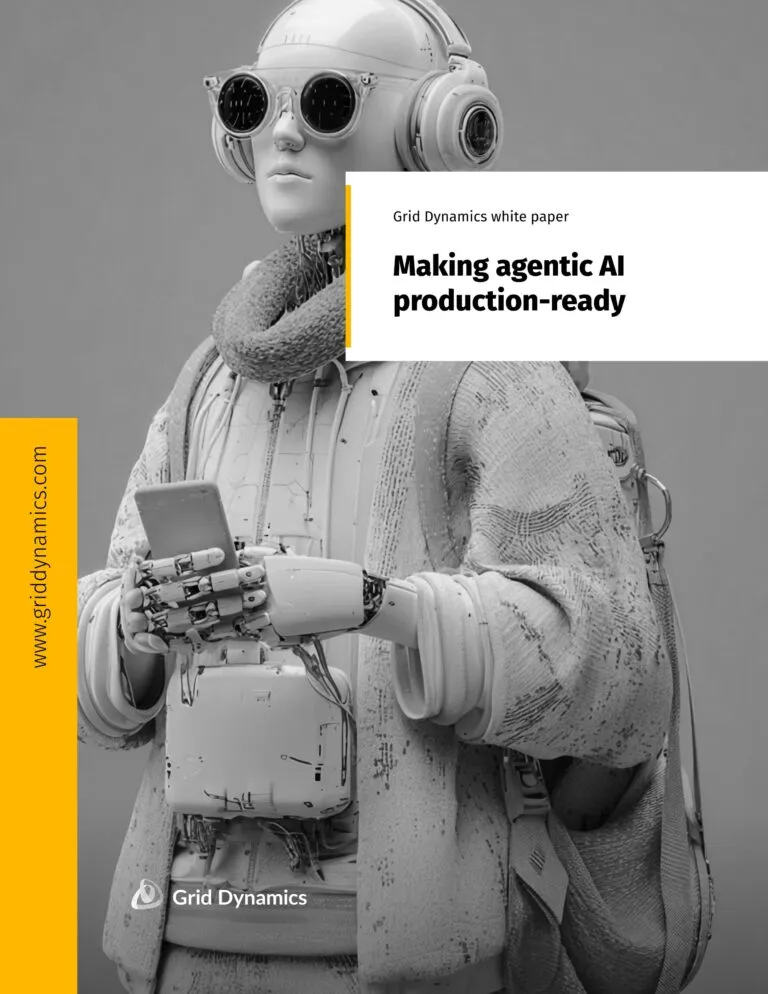Agentic AI now builds autonomously. Is your SDLC ready to adapt?
Jun 17, 2025 • 6 min read

According to Gartner, by 2028, 33% of enterprise software applications will include agentic AI. But agentic AI won’t just be embedded in software; it will also help build it. AI agents are rapidly evolving from passive copilots to autonomous builders, prompting organizations to rethink how they develop, test, and govern software, starting with a reimagined AI software development life cycle (SDLC).
Plan and execute your AI-native SDLC transformation
When we say “AI agent,” we’re referring to AI systems capable of taking high-level instructions and autonomously executing a multi-step, multi-layer development process, often spanning frontend, backend, infrastructure, and deployment. Their role is no longer limited to autocompleting snippets or suggesting boilerplate code. They’re now capable of independently generating full-stack features, marking the transition to an agentic development cycle where collaborating AI systems play a central role alongside human developers.

So, is the traditional SDLC still fit for purpose in this new AI-native engineering reality?
If a single developer can now prompt an AI to build, test, and deploy an entire application component, what happens to traditional silos like frontend, backend, and DevOps if the agent can navigate them all in one pass? How should teams be structured? How many such “prompt-native” developers does an organization actually need, and what new skills must they develop?
This brings us to the most critical question: Are organizations ready to reengineer the SDLC to embrace agentic AI capabilities? Only those who approach this structural shift with a mindset of intentional evolution will succeed. Let’s unpack how.
Redefining developer work with agentic AI in SDLC
The intentional evolution toward an agentic SDLC begins when engineering leaders revisit what “developer work” means in the AI era.
At one end of the spectrum is minimal assistance, such as simple code completions for familiar patterns. At the other end is agentic generation, where developers define high-level goals like “build a persistence layer,” and AI delivers full solutions across layers, files, and repositories. This shift demands a new understanding of intent, control, and delegation because developers are actively offloading architectural and implementation decisions to agents. As a result, their role is evolving into that of a supervisor, reviewer, and curator of outcomes, rather than the sole producer.
A recent study highlights this shift, with 92% of software developers believing agentic AI will help them advance in their careers.
For engineering leaders, this reframes the talent equation:
- Who is equipped to supervise complex agentic workflows?
- Can one person effectively review code quality across all layers?
- What mechanisms ensure software quality, alignment, and control when much of the code is AI-generated?
Based on internal benchmarks, we expect our AI software development model to accelerate project delivery with productivity gains exceeding 30%.
Why context is a key bottleneck for agentic development
Agentic systems need context to showcase their intelligence. While humans absorb context through experience, AI requires structured, connected data to understand its environment.
For example, in AI-powered DevOps, one of the most overlooked sources of risk is misaligned or opaque authorization logic. AI-generated services often produce access patterns, including roles, scopes, and permissions, that are technically functional but inconsistent with enterprise security policies. Without contextual grounding in existing IAM models or access control layers, agents may unknowingly introduce overexposed endpoints or unsafe defaults. Similarly, AI-generated code without situational awareness often introduces security risks, broken configurations, or misaligned infrastructure.
To move beyond hallucinated outputs, organizations must anchor AI activity in a real-time, system-aware context. Infrastructure-as-code should be mapped as a knowledge graph, not as disconnected scripts. Metadata about ownership, deployment states, and architectural dependencies should be available to agents in the same way experienced software engineers rely on tribal knowledge.
Organizations must design systems where contextual awareness is natively available to AI agents through observability, metadata, and infrastructure modeling. However, making context available is not the same as making it actionable. Leaders must still make deliberate choices about where autonomy begins, where oversight remains critical, and how to enforce safety boundaries.
Key questions on context that executives need to answer:
- How do we govern agent access to live infrastructure configurations, especially when that context is readily available?
- Who is accountable for changes initiated or executed by agents?
- Do we have review systems engineered to catch subtle, high-impact changes embedded in auto-generated outputs?
More code, more risk
AI is maximizing throughput as developers can now produce, test, and deploy code at a pace unimaginable just a few years ago. But this surge in developer productivity introduces a new operational paradox. While we build faster, the systems we build are becoming more fragmented, harder to maintain, and increasingly difficult to control.
More output means more surface area, more features, more services, more variations. On top of that, unlike traditional code, AI-generated code can lack consistent structure, naming conventions, or architectural cohesion. Development teams now face a mounting challenge of keeping systems coherent, testable, and aligned with business intent at scale.
The key risks aren’t about security exploits; they’re about growing entropy:
- Code snippets that work today but become unmaintainable tomorrow
- Functionally correct services that duplicate logic or diverge from architectural patterns
- Reduced developer confidence in systems they didn’t write and can’t easily trace
This highlights a critical need for development hygiene, not just in what gets written, but in how codebases evolve over time. It also raises important questions for executives:
- Are we tracking the architectural consistency of AI-generated outputs across teams?
- Do we have standards or frameworks for prompting and supervising multi-agent contributions?
- What mechanisms ensure that acceleration doesn’t lead to long-term technical debt?
An enterprise blueprint for adopting AI in SDLC
Even with the right systems and processes in place, building organizational trust is the foundation for successful adoption. This means enabling teams to understand how agent decisions are made, where human intervention is needed, and how transparency and explainability are maintained across workflows. The shift from experimentation to scale only happens when there’s a clear, focused strategy driving it.
Successful adoption of agentic development capabilities hinges on:
- Starting with mature, domain-aligned teams
- Favoring opt-in experimentation over top-down mandates
- Embedding feedback and measurement loops into agile rituals
- Tracking productivity, quality, and team sentiment equally
- Aligning licensing with real usage patterns, not hypothetical rollouts
To scale AI in SDLC, organizations must turn pilot insights into platform capabilities by embedding governance, context, and observability from the start. To do this effectively, executives must ask:
- Have we identified the right teams to pilot and champion AI-native workflows?
- Are we treating AI rollout as a capability shift or just a tooling decision?
- What mechanisms are in place to continuously capture feedback and improve our AI development practices?
- Are we setting up incentives, metrics, and infrastructure that support long-term adoption, not just short-term experimentation?
Evolving the SDLC for an agentic future
Traditional SDLC models were not built for a world where AI agents can span frontend, backend, infrastructure, and test automation with a single prompt. Instead of tearing it down, we must evolve it thoughtfully.
The shift toward agentic development calls for a gradual evolution. No rigid handoffs but rather orchestrated collaboration. Developers begin to act more like intent engineers, guiding agents with clear objectives and curating their outputs. Review processes begin to move beyond line-by-line code differences, introducing checks that ensure AI-generated outputs align with architectural intent and business purpose. Over time, pipelines will need to support faster, more automated decision-making while preserving human oversight where it matters most.
Rethinking agent boundaries
As organizations evolve their SDLC, they must also reconsider how agent responsibilities are scoped. The most effective agent boundaries will not mirror traditional human expertise but will instead align with where sufficient context, guardrails, and observability exist to support safe execution.
This allows agents to act autonomously where appropriate, spanning layers or functions, and defer to human oversight where complexity or risk demand it. In the agentic SDLC, context, not job title, defines the boundary of responsibility.
Designing agentic workflows with human oversight
Agents can perform end-to-end tasks, but that doesn’t mean they should do so unchecked. Multi-agent workflows must be designed with control points, especially in recursive or looped scenarios.
Backward loops, where agents rework or revise outputs based on prior steps, require memory, context sharing, and exit conditions. Without these, agents may conflict or introduce unintended complexity.
Equally important is designing workflows that intentionally embed user feedback. Instead of treating human input as an always-on review layer, leading teams are building workflows that:
- Route high-impact or ambiguous tasks to human reviewers
- Escalate when agent confidence or context is insufficient
- Assign oversight based on roles, not blanket review requirements
In the agentic SDLC, workflow design is not just a flowchart. It represents an orchestration layer that balances speed, quality, and human judgment, raising key questions for executives:
- Who should validate agent-generated logic across interconnected systems?
- How do we test workflows produced by multiple cooperating agents?
- Are the governance mechanisms real-time and resilient?
This transition to agentic development demands a platform-centric operating model where humans, agents, and systems collaborate continuously, challenging the core assumptions of the traditional SDLC as follows.
| Traditional SDLC | Agentic SDLC |
| Sequential handoffs between specialized teams | Compressed, cross-layer workflows led by agents |
| Human-written code, reviewed by humans | AI-generated code, supervised by humans |
| Fixed roles (frontend, backend, infra, QA) | Fluid roles (prompt engineer, system curator) |
| Manual reviews of code and config | Automated and intent-aligned validation |
| Team velocity as delivery driver | AI throughput with human oversight |
| Performance metrics: hours worked, velocity, defect rates | Performance metrics: agent utilization, output alignment |
| Governance through stage gates | Governance through real-time guardrails |
| Toolchains built for human users | Platforms built for human–agent collaboration |
Final thoughts
AI-native development may have begun as a tooling trend, but it’s now driving a systems-level transformation. To lead in this era, executive teams must:
- Redesign the SDLC for a hybrid workforce of humans and agents
- Invest in context infrastructure: metadata, infrastructure graphs, observability, and alignment with the business problems the code is intended to solve
- Shift security left and embed guardrails directly into code generation and execution
- Rethink roles around supervision, orchestration, and intent engineering
- Operationalize trust, auditability, and agility in real time
Success does not depend on who adopts the most tools, but on who evolves how software is built, trusted, and governed.
Ready to evolve your SDLC for the agentic era? Choose Grid Dynamics as your co-innovation partner, backed by over 8 years of AI engineering experience. Get in touch.
Tags
You might also like
Today, agentic AI can autonomously build, test, and deploy full-stack application components, unlocking new levels of speed and intelligence in SDLC automation. A recent study found that 60% of DevOps teams leveraging AI report productivity gains, 47% see cost savings, and 42% note improvements in...

Today, many organizations find themselves grappling with the developer productivity paradox. Research shows that software developers lose more than a full day of productive work every week to systemic inefficiencies, potentially costing organizations with 500 developers an estimated $6.9 million an...
Fortune 1000 enterprises are at a critical inflection point. Competitors adopting AI software development are accelerating time-to-market, reducing costs, and delivering innovation at unprecedented speed. The question isn’t if you should adopt AI-powered development, it’s how quickly and effectivel...
When it comes to the best web development frameworks, finding the right balance between efficiency, creativity, and maintainability is key to building modern, responsive designs. Developers constantly seek tools and approaches that simplify workflows while empowering them to create visually strikin...
Most enterprise leaders dip their toe into AI, only to realize their data isn’t ready—whether that means insufficient data, legacy data formats, lack of data accessibility, or poorly performing data infrastructure. In fact, Gartner predicts that through 2026, organizations will abandon 60% of AI pr...

For many businesses, moving away from familiar but inherently unadaptable legacy suites is challenging. However, eliminating this technical debt one step at a time can bolster your confidence. The best starting point is transitioning from a monolithic CMS to a headless CMS. This shift to a modern c...
Many organizations have already embraced practices like Agile and DevOps to enhance collaboration and responsiveness in meeting customer needs. While these advancements mark significant milestones, the journey doesn't end here. Microservices offer another powerful way to accelerate business capabil...









